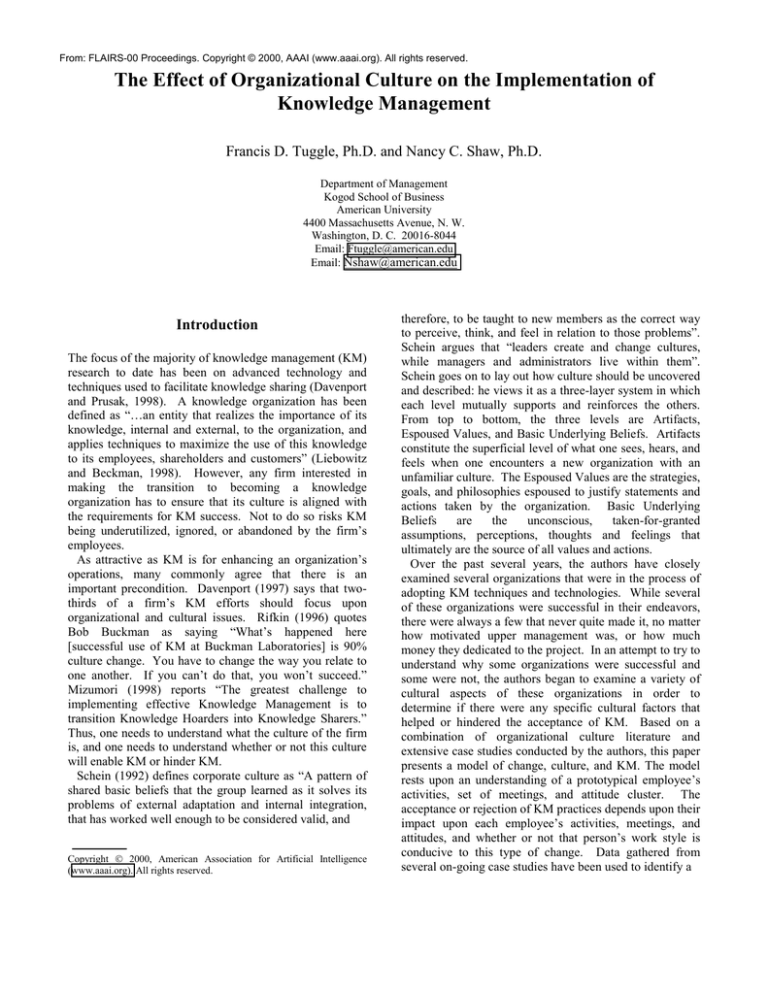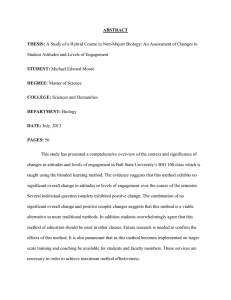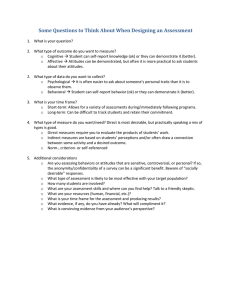
From: FLAIRS-00 Proceedings. Copyright © 2000, AAAI (www.aaai.org). All rights reserved.
The Effect of Organizational Culture on the Implementation of
Knowledge Management
Francis D. Tuggle, Ph.D. and Nancy C. Shaw, Ph.D.
Department of Management
Kogod School of Business
American University
4400 Massachusetts Avenue, N. W.
Washington, D. C. 20016-8044
Email: Ftuggle@american.edu
Email: Nshaw@american.edu
Introduction
The focus of the majority of knowledge management (KM)
research to date has been on advanced technology and
techniques used to facilitate knowledge sharing (Davenport
and Prusak, 1998). A knowledge organization has been
defined as “…an entity that realizes the importance of its
knowledge, internal and external, to the organization, and
applies techniques to maximize the use of this knowledge
to its employees, shareholders and customers” (Liebowitz
and Beckman, 1998). However, any firm interested in
making the transition to becoming a knowledge
organization has to ensure that its culture is aligned with
the requirements for KM success. Not to do so risks KM
being underutilized, ignored, or abandoned by the firm’s
employees.
As attractive as KM is for enhancing an organization’s
operations, many commonly agree that there is an
important precondition. Davenport (1997) says that twothirds of a firm’s KM efforts should focus upon
organizational and cultural issues. Rifkin (1996) quotes
Bob Buckman as saying “What’s happened here
[successful use of KM at Buckman Laboratories] is 90%
culture change. You have to change the way you relate to
one another. If you can’t do that, you won’t succeed.”
Mizumori (1998) reports “The greatest challenge to
implementing effective Knowledge Management is to
transition Knowledge Hoarders into Knowledge Sharers.”
Thus, one needs to understand what the culture of the firm
is, and one needs to understand whether or not this culture
will enable KM or hinder KM.
Schein (1992) defines corporate culture as “A pattern of
shared basic beliefs that the group learned as it solves its
problems of external adaptation and internal integration,
that has worked well enough to be considered valid, and
Copyright 2000, American Association for Artificial Intelligence
(www.aaai.org). All rights reserved.
therefore, to be taught to new members as the correct way
to perceive, think, and feel in relation to those problems”.
Schein argues that “leaders create and change cultures,
while managers and administrators live within them”.
Schein goes on to lay out how culture should be uncovered
and described: he views it as a three-layer system in which
each level mutually supports and reinforces the others.
From top to bottom, the three levels are Artifacts,
Espoused Values, and Basic Underlying Beliefs. Artifacts
constitute the superficial level of what one sees, hears, and
feels when one encounters a new organization with an
unfamiliar culture. The Espoused Values are the strategies,
goals, and philosophies espoused to justify statements and
actions taken by the organization. Basic Underlying
Beliefs
are
the
unconscious,
taken-for-granted
assumptions, perceptions, thoughts and feelings that
ultimately are the source of all values and actions.
Over the past several years, the authors have closely
examined several organizations that were in the process of
adopting KM techniques and technologies. While several
of these organizations were successful in their endeavors,
there were always a few that never quite made it, no matter
how motivated upper management was, or how much
money they dedicated to the project. In an attempt to try to
understand why some organizations were successful and
some were not, the authors began to examine a variety of
cultural aspects of these organizations in order to
determine if there were any specific cultural factors that
helped or hindered the acceptance of KM. Based on a
combination of organizational culture literature and
extensive case studies conducted by the authors, this paper
presents a model of change, culture, and KM. The model
rests upon an understanding of a prototypical employee’s
activities, set of meetings, and attitude cluster. The
acceptance or rejection of KM practices depends upon their
impact upon each employee’s activities, meetings, and
attitudes, and whether or not that person’s work style is
conducive to this type of change. Data gathered from
several on-going case studies have been used to identify a
Organizational Culture
Individual Work Style
Knowledge Management
•
Artifacts
•
Activities
•
Required Behaviors
•
Values
•
Meetings
•
Interconnectivity
•
Beliefs
•
Attitudes
•
Necessary
Sentiments
Knowledge Management
Acceptance or Rejection
Figure 1. A Model of Change, Culture and Knowledge Management
list of cultural facilitators and inhibitors to KM. Firms can
use this model to assess their ability to make the transition
to a knowledge organization, and to identify elements in
their cultures needing change before a transition can be
successfully undertaken. Unless the organization’s culture
supports changes to the worker’s daily activities, meeting
patterns and attitudes, KM will not succeed in the
organization.
In contrast with market/industry factors and
organizational factors, there is little in the published
literature that is helpful in specifically assessing cultural
dimensions of organizations for their suitability for
supporting or inhibiting progress towards KM. Thus, the
factors we identify in this paper are largely based upon our,
and others’, empirical observations about the adoption and
use of knowledge management in organizations, and cases
where KM has proven troublesome to implement.
A Model of Change, Culture and Knowledge
Management
For an organization to adopt KM successfully, the practice
of KM must be integrated into the day-to-day routines of
the organization’s employees. To derive the specific
factors in the culture that serve as facilitators and barriers,
it is first necessary to examine a model of an employee’s
daily work routines so as to determine whether
technological changes will be assimilated or resisted.
When one introduces any KM technology into the firm,
all facets of an employee’s daily routines get altered.
Whether KM is readily adopted as a practice in the
organization or is rejected by the organization is dependent
upon whether or not the affected workers are able to
assimilate changes to their daily routines that the use of
KM necessitates. A worker’s daily routines may be
summarized as consisting of a set of Activities (what the
worker does alone—writes reports, gives directions,
prepares budgets, analyzes data, etc.), a set of Meetings
(what the worker does in conjunction with other people—
exchanges information, receives direction, learns new facts
and concepts, coordinates schedules, collaborates on group
tasks, etc.), and supported by a set of Attitudes (concerning
the work performed, the people interacted with, the
technology used to get things done, the goals of the group
and organization, the pace of work, etc.). According to
Homans (1950), these three factors (Activities, Meetings,
and Attitudes) form a tightly bonded system for an
individual who has reached a stable position within a group
(e. g., an employee who has worked for the firm long
enough to establish a routine work pattern). According to
Homans, to change any one of these three is to cause
changes in the other two.
The particular form these three work routine factors take
is heavily conditioned by the culture of the organization.
Thus, the Artifacts of the firm (the visible tools that
embody the culture) affect how Activities get performed
(networked personal computers or automobile production
line?), how Meetings get conducted (around a water cooler
or in a conference room with a clearly designated leader?),
and which particular set of Attitudes are held
(disappointment in being consigned to a cubicle or pride in
using the latest equipment?). The Values of the firm affect
which Activities get performed and how they are carried
out, the subject matter of Meetings and the goals of the
group, and the set of supporting Attitudes that provide the
level of enthusiasm for carrying out the Activities and
Meetings. The Beliefs that underlie the firm dictate why
the particular set of Activities is the only set that “makes
sense” for the firm to undertake, why the particular set of
Meetings is the “correct” set for the firm to engage in, and
why the particular set of Attitudes is the “proper” mindset
for people in the firm to hold. That is, the culture of the
firm establishes the range of viable possibilities for
people’s Activities, Meetings, and Attitudes.
With that framework in place, consider now the situation
of introducing KM as a new practice in the firm. To
practice KM, it is necessary to engage in a different set of
behaviors. That is, there is a set of Required Behaviors to
execute KM (e. g., data warehouses to be built, data mining
routines to be run, and lessons learned databases to be
posted and referred to). These entail changes to the
worker’s Activities (what steps the worker carries out each
day) and the worker’s Attitudes (to use KM successfully,
the worker must adopt a set of Necessary Sentiments—that
KM is a valuable activity, that it benefits the organization,
that it is a useful tool to learn, etc.). Unless the culture
supports changes to the worker’s Activities and Attitudes,
KM will not succeed in the organization.
Likewise, introducing KM involves changes to the
worker’s Interconnectivity—the worker’s set of Meetings
is altered (how the meetings are conducted, which
information gets exchanged, the range of information that
gets exchanged, the frequency of information exchange,
etc.) and the worker’s set of Attitudes is also affected (that
sharing information is a good thing to happen, that
different meeting formats are acceptable, that work in
group settings is desirable, etc.). Again, to use KM
successfully, there are Necessary Sentiments regarding the
propriety of relying upon computer technology, having
sufficient skills that this technology is not threatening,
information sharing, teamwork, and informational
egalitarianism—if these are not acceptable to the
organizational culture, the culture will need to be changed
to allow KM to function as intended.
To summarize, a firm that introduces KM in the
workplace will be successful in that endeavor to the extent
that the workers accept the new work system. In turn, the
workers will accept KM to the extent that the culture of the
firm that they work in allows changes to their individual
daily routines of Activities, Meeting patterns, and
Attitudes.
Cultural Facilitators and Barriers for Adopting
Knowledge Management
Applying our model to several different organizations that
were undergoing the transition to a KM company over the
past few years has elicited a set of cultural facilitators and
barriers for adopting KM. One of our findings is that there
are no facilitators or barriers per se. A facilitator that is
absent or appears in the reverse serves as a barrier, and
vice versa. Another finding is that there are, in general,
two sets of cultural factors—general ones that apply to any
organization undertaking technological change and ones
specific to adopting KM. We found 12 of the first type and
5 of the second.
Factors Relevant to General Technological Change
•
•
•
•
•
•
•
•
•
•
•
•
Is the culture strong or weak?
Is the culture positive or negative?
Is the culture adaptive or rigid?
Is there information sharing (both on the demand side
and the supply side) or information hoarding?
Is there trust or distrust in the organization?
Is the organization technologically advanced or
technologically innocent?
Does the reward and recognition system promote
Initiative and Innovation, or Stability and the Status
Quo?
Are people in the organization intellectually curious or
incapable of learning; are they given the freedom to
explore or is their discretion curtailed; is knowledge
production valued or discouraged by the organization?
Is there a “not-invented-here” syndrome?
Is there an intolerance of well-intentioned errors; is
there an intolerance of people who seek assistance?
Does the organization overemphasize the value of
creativity and originality?
Does the organization stress individualism or
teamwork?
Factors Specific to Knowledge Management
•
•
•
•
•
Do present organizational practices support the
adoption of KM?
Do the organization’s compensation, recognition, and
reward systems support the adoption of KM?
Do the organization’s control, decision making, and
communications systems support the adoption of KM?
Do the employees’ work styles and patterns support
the adoption of KM?
Do the employees’ attitudes and skills support the
adoption of KM?
Each of these 17 factors can be examined for its impact
on an employee’s activities, meetings, and attitudes. For
example, to the extent that employees already work in a
team environment, the adoption of KM will be eased.
Workers will be comfortable getting skill concerns
resolved through co-workers (as opposed to asking the
boss questions possibly labeled as “dumb”). The
individual’s attitudes will be calibrated to the group’s
norms, which may or may not be supportive of change and
high technology. By reference to our model of individual
daily routines, teamwork impacts all three dimensions
(activities, meetings, and attitudes) positively.
Conversely, a firm wherein employees do not trust the
firm, superiors, or coworkers is a firm in which people feel
that their job is safe only till the end of the day. In this
type of firm, people feel that they must “look out for
number one.” This makes all meetings occasions in which
one tries to score points with superiors and avoid losing to
internal competitors, as opposed to occasions to share. The
attitude cluster focuses around issues of personal success
and protecting one’s image.
One could perform the same set of reasoning with each
of the other 16 factors.
Conclusion
The introduction of KM to an organization can be enabled
or hindered by that organization’s culture. One way to
assess an organization’s cultural readiness to adopt KM
would be to examine the impact of KM on an employee’s
set of activities, meetings and attitudes.
If the
organization’s culture facilitates changes to the
individual’s daily work routines, the employee is more
likely to accept the new work system. We have offered a
model to help organizations assess whether or not their
present culture is suitable for the successful
implementation of KM. This model has been grounded in
a set of case studies of successful KM adoption and cases
studies where KM failed to take hold.
References
Davenport, T. H. 1997. Known Evils, Common Pitfalls of
Knowledge Management. CIO Magazine. June 15, 1997.
Davenport, T. H. and Prusak, L. 1998. Working
Knowledge: How Organizations Manage What They
Know. Boston, Massachusetts: Harvard Business School
Press.
Freedman, A. 1997. The Undiscussable Sides of
Implementing Transformational Change. Consulting
Psychology Journal. Winter, 1997.
Homans, G. 1950. The Human Group. New York:
Harcourt, Brace and Company.
Liebowitz, J. and Beckman, T. 1998. Knowledge
Organizations: What Every Manager Should Know. Boca
Raton, Florida: St. Lucie Press.
Mizumori, R. K. 1998. Knowledge Management—5 W’s
& 1 H. KM Magazine. November, 1998.
Rifkin, G. 1996. Buckman Labs: Nothing But Net. Fast
Company. June/July, 1996.
Schein, E. 1992. Organizational Culture and Leadership
(second edition). San Francisco, CA.: Jossey-Bass
Publishers.








